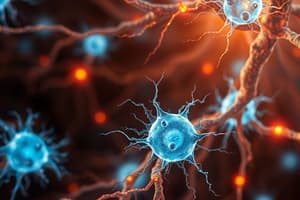Podcast
Questions and Answers
What are neuroglial cells?
What are neuroglial cells?
- Cells that send and receive messages (correct)
- Cells that form myelin sheath
- Cells that protect neurons
- Cells that support neurons (correct)
What is the function of astrocytes?
What is the function of astrocytes?
They form the blood-brain barrier by holding together neurons and blood vessels.
What do oligodendrites form around axons?
What do oligodendrites form around axons?
The myelin sheath.
What is the role of microglia?
What is the role of microglia?
What do ependymal cells form?
What do ependymal cells form?
What is the main function of Schwann cells?
What is the main function of Schwann cells?
What is a neurolemma?
What is a neurolemma?
What do satellite cells do?
What do satellite cells do?
What does CNS stand for?
What does CNS stand for?
What does PNS stand for?
What does PNS stand for?
What is the function of the afferent division?
What is the function of the afferent division?
What does the efferent division do?
What does the efferent division do?
What does integration in the nervous system mean?
What does integration in the nervous system mean?
What is sensory input?
What is sensory input?
What is motor output?
What is motor output?
What is the somatic nervous system responsible for?
What is the somatic nervous system responsible for?
What does the autonomic nervous system control?
What does the autonomic nervous system control?
Flashcards are hidden until you start studying
Study Notes
Neuroglial Cells Overview
- Neuroglial cells support, nourish, and facilitate communication between neurons.
Types of Neuroglial Cells
- Astrocytes: Star-shaped cells forming the blood-brain barrier (BBB) by linking neurons and blood vessels in a two-layered structure.
- Oligodendrites: Responsible for myelin sheath formation around axons in the central nervous system (CNS) and aiding in holding nerve fibers together.
- Microglia: Phagocytic cells that migrate within the CNS, playing a critical role in removing foreign matter and degenerated tissue.
- Ependymal Cells: Epithelial cells lining the brain and spinal cord involved in cerebrospinal fluid (CSF) production and circulation.
- Schwann Cells: Produce myelin sheaths around axons in the peripheral nervous system (PNS).
- Neurolemma: The outer membrane of Schwann cells crucial for the regeneration of cut or injured nerves.
- Satellite Cells: Provide support to neuron cell bodies in the PNS.
Nervous System Structure
- Central Nervous System (CNS): Comprises the brain and spinal cord.
- Peripheral Nervous System (PNS): Consists of nerves outside the CNS, including 31 spinal nerves and 12 cranial nerves.
Nervous System Functions
- Afferent Division: Nerve fibers that transmit information to the CNS.
- Efferent Division: Nerve fibers that convey impulses away from the CNS.
- Integration: The process of interpreting sensory input and determining necessary actions.
- Sensory Input: The collection of information monitoring changes in the internal and external environment.
- Motor Output: The response generated to integrated stimuli, activating muscles or glands.
Nervous System Subdivisions
- Somatic Nervous System: Involuntary control over skeletal muscles, associated with voluntary actions.
- Autonomic Nervous System: Controls involuntary functions, such as those in cardiac muscles.
Studying That Suits You
Use AI to generate personalized quizzes and flashcards to suit your learning preferences.




